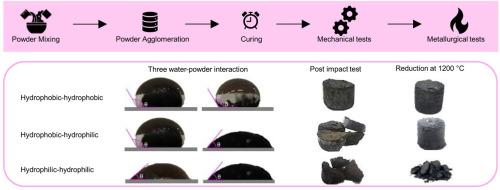Effect of water-powder interaction on the mechanical and metallurgical behavior of integrated steel plant byproducts agglomerates
IF 4.3
2区 材料科学
Q2 ENGINEERING, CHEMICAL
引用次数: 0
Abstract
In 2023, 1888 Mt of steel were produced worldwide, with 70 % via integrated cycle steel plant, generating 34 Mt of dust and 25 Mt of sludge. These wastes are rich in Fe and C but are too fine for direct recycling. Agglomeration is therefore essential to recycle them as suitable feedstock. This work studies how water–powder interactions affect the mechanical (impact resistance, cold compressive strength) and metallurgical (degree of reduction, swelling) properties of self-reducing briquettes made by combining two iron-bearing dusts (BOF dust and a secondary dust) with two reducing agents (BF sludge and another secondary dust) to form hydrophilic–hydrophilic, hydrophobic–hydrophilic, and hydrophobic–hydrophobic mixtures. Water expelled from hydrophobic dust acts as a lubricant during compaction, reducing surface cracks and enhancing eight times the impact resistance. Hydrophilic particles, however, lower impact resistance (failing 10-drop tests) due to hydration repulsion that weakens the briquette. While water absorbed by hydrophilic powders forms gasification channels on drying, enabling a reduction degree up to 94 %, it also causes severe swelling below 1200 °C. The best overall performance was achieved by a hydrophobic–hydrophilic combination with double water content, yielding compressive strength of 18 MPa, degree of reduction of 91 % and swelling of −1.86 %.

水粉相互作用对综合炼钢副产物结块力学和冶金行为的影响
2023年,全球钢铁产量为1888亿吨,其中70%是通过综合循环钢铁厂生产的,产生了3400万吨粉尘和2500万吨污泥。这些废物富含铁和碳,但太细,不能直接回收。因此,团聚对于回收它们作为合适的原料至关重要。本工作研究了水粉相互作用如何影响两种含铁粉尘(转炉粉尘和一种二次粉尘)与两种还原剂(高炉污泥和另一种二次粉尘)结合形成亲水-亲水、疏水-亲水、疏水-疏水混合物的自还原性型煤的机械(抗冲击性、冷抗强度)和冶金(还原程度、膨胀)性能。从疏水性粉尘中排出的水在压实过程中起到润滑剂的作用,减少表面裂缝,并提高8倍的抗冲击性。然而,亲水颗粒的抗冲击性较低(未能通过10次跌落试验),因为水合排斥会削弱型煤。虽然亲水性粉末吸收的水在干燥时形成气化通道,使还原度高达94%,但在1200°C以下也会引起严重的肿胀。疏水-亲水复合,双含水率可获得最佳的综合性能,抗压强度为18 MPa,减压度为91%,溶胀率为- 1.86%。
本文章由计算机程序翻译,如有差异,请以英文原文为准。
求助全文
约1分钟内获得全文
求助全文
来源期刊

Particuology
工程技术-材料科学:综合
CiteScore
6.70
自引率
2.90%
发文量
1730
审稿时长
32 days
期刊介绍:
The word ‘particuology’ was coined to parallel the discipline for the science and technology of particles.
Particuology is an interdisciplinary journal that publishes frontier research articles and critical reviews on the discovery, formulation and engineering of particulate materials, processes and systems. It especially welcomes contributions utilising advanced theoretical, modelling and measurement methods to enable the discovery and creation of new particulate materials, and the manufacturing of functional particulate-based products, such as sensors.
Papers are handled by Thematic Editors who oversee contributions from specific subject fields. These fields are classified into: Particle Synthesis and Modification; Particle Characterization and Measurement; Granular Systems and Bulk Solids Technology; Fluidization and Particle-Fluid Systems; Aerosols; and Applications of Particle Technology.
Key topics concerning the creation and processing of particulates include:
-Modelling and simulation of particle formation, collective behaviour of particles and systems for particle production over a broad spectrum of length scales
-Mining of experimental data for particle synthesis and surface properties to facilitate the creation of new materials and processes
-Particle design and preparation including controlled response and sensing functionalities in formation, delivery systems and biological systems, etc.
-Experimental and computational methods for visualization and analysis of particulate system.
These topics are broadly relevant to the production of materials, pharmaceuticals and food, and to the conversion of energy resources to fuels and protection of the environment.
 求助内容:
求助内容: 应助结果提醒方式:
应助结果提醒方式:


